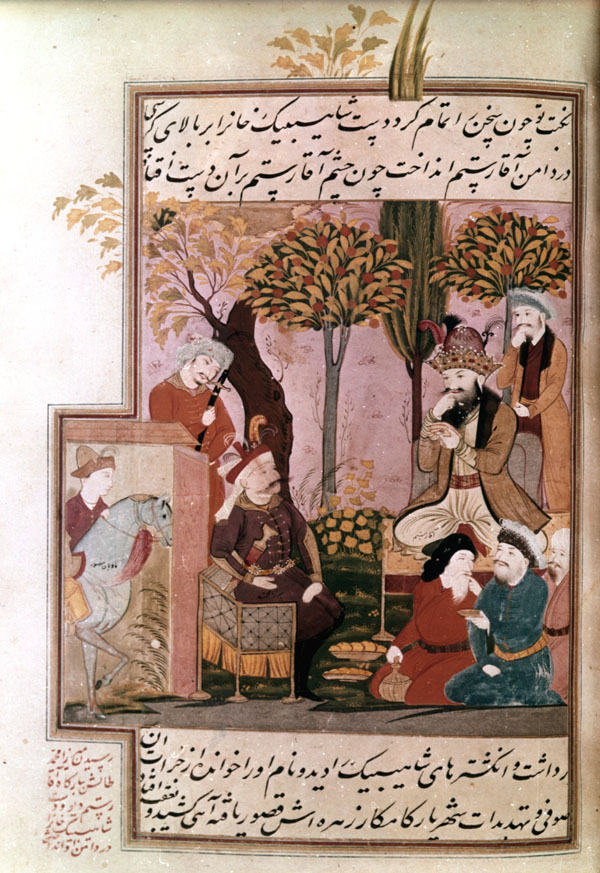Manuscripts
tāriḵ-e ʿālām-ārā-ye šāh esmāʿil
Both this text and the testimony of Eskandar Monshi relate the same circumstances. Āqā Rostam Ruz-Afzun ruled Māzandarān under Šāhibeg Ḵān. Following the demise of Šāhibeg (see f.210), Shah Esmāʿil had his body dismembered and sent a severed hand with an aide-de-camp, Mirzā Moḥammad (not identified by Monshi), with instructions to toss it in the lap of Āqā Rostam with the words “his protection has availed you nothing; now his hand lies in your lap”. The aide-de-camp entered when Āqā Rostam was in council with high officials of the province, discharged his commission fearlessly, and left immediately. Not a soul had a chance to speak. Āqā Rostam, was petrified with fear and his heart failed him. Day by day he became weaker and eventually died.
Āqā Rostam, with a beige-gray robe, tan coat with fur collar, black beard and bejeweled crown, sits on a raised dais holding the severed hand of Šāhibeg Ḵān, his finger raised to his lip in astonishment. An attendant in burgundy robe and orange coat stands behind him making the same gesture. In the lower left, Mirzā Moḥammad in a purple uniform with gold trim, black boots, and the red and white tāj, sits facing Āqā Rostam. A long dagger is stuck in his belt. An attendant stands behind him holding a sword in ceremonial position. Three elderly men, apparently the high officials of the province, are seated in the lower right, beverages and sweets before them. The scene is a lush outdoor setting, the artist apparently wishing to convey the semi-tropical environment of Māzandarān. The foreground is green with touches of yellow; the background light pink with a golden sky. Four trees - a craggy čenār, a slender cypress, and two lollipop-like orange trees - are evenly disposed as in a stage set. In the lower left the frame bulges out to encompass a small stable, shown in cross-section, with Mirzā Moḥammad’s horse and groom.

Painting: 22.2 x 15.5 cm. Two lines of text above and below the painting. Frame encloses painting and text except for the Āqā Rostam čenār and cypress trees that protrude into the margins. One small hole in the lower left; no other signs of damage or retouching. A marginal inscription in red in the lower left corner, presumably of later date, describes the event. Inscriptions in black identify Mirzā Moḥammad and Āqā Rostam, and the horse in the lower left stating it to be the “mule of Manṣur”.
Painting references:
Mahboubian_1972, #923 folio 217 (not ill.).
Text X-references:
See Muntaẓer-Ṣāḥeb_1970, p.379 for this event in the History of Shah Esmāʿil.
See Savory, SA_1979, pp.62-63 for this event in the History of Shah ʿĀbbās.
Robert Eng
Last Updated: December 15, 2010
Originally published: April 4, 2002